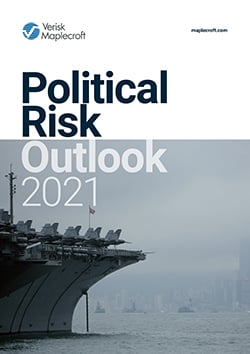Political risk enters the age of flux and flex
Political Risk Outlook 2021
by Matthew Moshiri,
This insight is part of our Political Risk Outlook 2021, which explores five key themes we’re tracking for our clients this year. You can find the other themes at our #PRO21 hub, as well as related webinars.
If the last 12 months has taught us anything it’s that risk needs to be hard baked into every decision we make. It’s impossible to predict when high-impact events like a pandemic will occur, but taking a forward-looking view on threats to resilience and their implications should now be top of mind for global business. In this year’s Political Risk Outlook, we explore where, how and why some of the key challenges might emerge in what has become an unprecedented period of change.
2020’s legacy – debt, unrest and creeping volatility
Outside of health, it is economically that the impacts of the Covid crisis have been felt most sharply. Reflecting on the biggest movers and shakers of 2020 in our suite of risk indices provides key signals to some of the market-shifting risks that may develop over the next year and beyond. By far the greatest levels of volatility in the 160 risk issues we measure were seen in 10 of our economic indices, including Economic Growth and Fiscal Balance.
88 countries
will likely see elevated political risks over the next 2 years
With growth stagnating and many government balance sheets in disarray, the knock-on impacts of rising levels of debt and less flexibility on social spending will have far-reaching consequences. Against this backdrop, we forecast that political instability will rise in 88 countries. Of those, our projections point to 23 nations, including Brazil, the Philippines and several eastern European emerging markets, where unrest, flaring political divisions and erratic policy making have worrying potential to severely impact the investment environment.
Governments falling back on resource nationalism
Mineral-rich countries are already attempting to regain some fiscal firepower to offset these risks. Since the start of 2020, 18 countries that rely on the hard commodities they produce saw a significant rise in risk in our Resource Nationalism Index. The drivers of the increase are varied. But one thing is for sure, we’ve seen this trend accelerate in our data since 2017, and more governments are now willing to go down the resource nationalism route.
We also expect the threat to expand even further over the next two years as countries that are economically dependent on the minerals they export try to claw back financial losses from the pandemic. The risks will be highest in Africa and Latin America, and the mining industry will be lined up to take the brunt of new measures.
Energy transition will catalyse political risk for least competitive oil producers
It’s not just the mining industry that is in for a bumpy ride though. If Covid has hollowed out any gains oil made over the last few years, the energy transition will hammer all but the most competitive producing countries. Those with the highest break-even prices and the least economic diversification are the ones that will suffer most.
Our data pinpoints Iraq, Nigeria and Algeria as first in line to face a slow-motion tsunami of political instability over the next 3-20 years, but African fossil fuel producers including Angola, Equatorial Guinea and Gabon are not far behind. Watch out for step changes in credit risk and policy or regulatory volatility, as the worst placed exporters enter doom loops of shrinking hydrocarbon revenues, political turmoil, and failed attempts to jump start flat-lining non-oil sectors.
China’s pivot to authoritarian states for strategic resources shifts geopolitical sands
Natural resources are also high on the list for China as it tries to lock up its resource security and remove any vulnerabilities it has in its reliance on countries it deems hostile. China is redrawing the geopolitical map in the process and the implications are sweeping – not only for its major strategic commodity trading partners, but also for the extractive companies deeply invested in them. Our data shows China is pivoting towards more autocratic regimes that represent greater stability for its supply lines. But it is also using its massive market as a source of diplomatic leverage. By securing diversified sources, China will be in a better position to weaponise trade with geopolitical rivals.
...geostrategic competition between Washington and Beijing will be the single most important factor shaping the global risk landscape....
Matt Moshiri
President, Verisk Maplecroft
US vs China – heavyweight match-up tops geopolitical billing
If anyone doubted Beijing’s intent to achieve its strategic aims they should look at Hong Kong, where its grip has tightened. As we predicted in our 2020 Human Rights Outlook, civil and political rights in the city have suffered. Over the last year, Hong Kong saw the largest negative shift in risk of any country or territory based on a combination of our indices covering human security, democratic governance and government stability.
With China’s emergence as a rival superpower, the geostrategic competition between Washington and Beijing will be the single most important factor shaping the global risk landscape for corporates and investors.
To put this in context, we kick off the outlook by using our predictive Interstate Tensions Model to identify the key geopolitical hotspots that have the potential to spill over into a military confrontation in the year ahead. That can mean threats, posturing, direct conflict or anything in between. But the important thing to bear in mind is that the US vs China is among the top global flashpoints where the chances of escalation are greatest. The stakes are high and miscalculation or human error on either side could be catastrophic.
